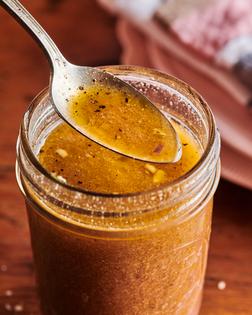The Kitchn: The untraditional formula for a better, more flavorful vinaigrette
The classic ratio of three parts oil to one part acid has long been touted by chefs, culinary instructors, cookbook authors and food experts as the ultimate vinaigrette formula. But as our preference for salads has shifted toward flavorful, bright and punchy, this old-school formula, which produces a dressing that is palatable yet dull, comes up short.
The solution is simple: Ditch the 3:1 ratio for a 1:1 ratio with equal parts oil and vinegar. The increase in acid makes a brighter, more flavorful and infinitely better vinaigrette, ready to take leafy greens and crunchy veggies to whole new heights. To help you master it, we’ve created a choose-your-own-adventure-style recipe for making it at home, which breaks down exactly how much oil, vinegar, sweetener, and seasoning you need and provides multiple options for each.
The best acids for vinaigrettes
The two most common acids used in vinaigrettes are citrus juice and vinegar. Citrus juice adds brightness and a touch of sweetness. Lemon, lime, orange and grapefruit juice are all great options; each impart a slightly different flavor, and you can mix and match juices to create a more complex flavor profile.
Vinegar, on the other hand, can take your dressing in several different directions. Using balsamic vinegar will give your vinaigrette a rich, jammy flavor profile, while red wine vinegar will result in a punchier, more fruit-forward flavor. Just about any vinegar will work, so feel free to use your favorite in this formula. We recommend avoiding distilled white vinegar, as it lacks flavor and can be too harsh, but any other vinegar is fair game.
The best oils for vinaigrettes
Olive oil is the most popular choice, and its pleasant flavor works well in most salad dressings. But if you’re looking for a different flavor (or don’t have olive oil on hand), there are a handful of other oils you can use instead.
If flavor is what you’re after, try using sesame, walnut or pistachio oil. If you’re looking for something more neutral, try using grapeseed, peanut or sunflower oil. You can also use a combination of oils to achieve a balance of flavors. Our formula calls for 1/2 cup oil, so if you like the flavor of sesame oil but worry it’s too strong, try using 1/4 cup sesame oil cut with 1/4 cup grapeseed oil.
Adding a hint of sweetness
Sugar, just like salt, is a crucial component to vinaigrette — dressings can taste harsh or overpowering if not seasoned correctly. A touch of sweetness mellows the vinaigrette and helps balance the flavors. We recommend using sweeteners that are already in liquid form to make sure they completely dissolve. Honey, maple syrup and agave nectar are all great choices, with the latter being the most neutral. Our recipe calls for two tablespoons, which won’t make the vinaigrette taste sweet, but rather help elevate the flavors and round everything out.
...continued







